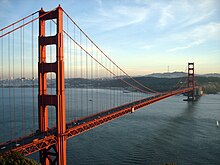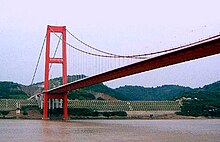
Benchmarking of Red-colored Bridges
While being stuck in traffic at the Golden Gate bridge during my last San Francisco trip, an idea occurred to me. How about I do some research work to benchmark all suspension bridges in the world?
A quick check at Wikipedia gave me over one hundred candidates, leading me to restrict my ambitious plan to only the red-colored bridges. That made sense, because the red colored bridges attract unusually high number of tourists and therefore should be an ideal subset representing all traffic-heavy suspension bridges.
After carefully considering all relevant factors, I picked the following bridges -
1. 25 de Abril Bridge, Portugal


3. Golden Gate Bridge, San Francisco, USA

5. Hirado Bridge, Nagashaki, Japan

Benchmarking Criteria and Funding
For the purpose of my study, I selected the following criteria. I will drive on the above bridges through every available access road on three different days of the week and at three different times during the day - early morning, midday and later in the evening.
I collected some preliminary data on the Golden Gate bridge accordingly and applied for a grant from NIH to do benchmarking. The grant application made my hobby project appear relevant for human health, as you can see from the introduction -
Rapid access to medical care is one of the biggest concerns, and overcrowded bridges and highways can lead to fatality for those patients seeking emergency treatment. This study will investigate the time of access across the busiest suspension bridges of the world.
To make the research project even more relevant for human health, I threw in a few irrelevant and arbitrary observations such as two of the selected bridges have the highest suicide rates. What the heck !!
The project got funded !!
Finally the Paper
After completing my study, I wrote a paper and submitted to the most respected civil engineering journal. All three reviewer agreed about the importance of my study and replied using one letter technical jargon that I did not understand.
Reviewer 1: LOL.
Reviewer 2: LOL.
Reviewer 3: LOL.
My civil engineer friend working on construction projects helped me out by sending me a larger email explanation.
Dude,
Just like a computer program moves data from hard-disk to memory and back to hard-disk, a bridge moves people around. Before constructing a bridge, we collect extensive amount of field-data, construct a model on expected traffic flow and design the bridge. That design includes various other factors including cost and margin of error that you did not pay attention to.
You can surely drive up and down the bridges a few times and write travel notes about how cold Golden Gate bridge is during mid-summer, but I do not see what your paper will do to the technical aspect of our field.
I disagree, because as a user, I have a right to benchmark the bridges and as a researcher, I have a right to publish those result in a scientific journal. I am wondering whether to pay PLOS One to publish my paper or send it to open access site homolog.us and save $1350.
Legal Disclaimer
The above story is fictitious and is not related to growing number of bioinformatics papers trying to ‘benchmark’ various software programs as black boxes without any discussion about the underlying algorithms.
